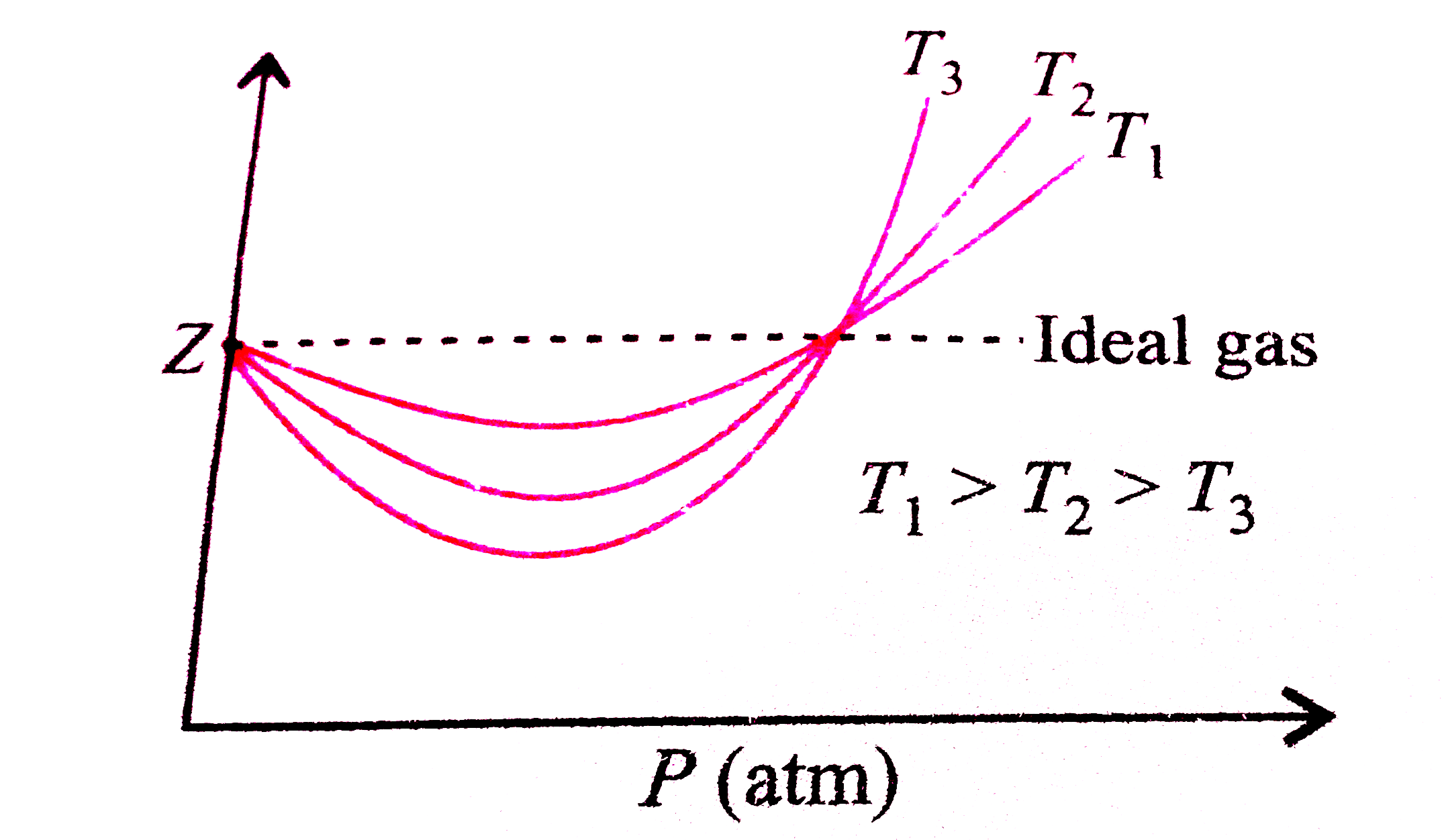The ideal gas equation is PV = nRT.Since none of the gas in universe is ideal one and deviation are noticed from ideal gas nature. The deviation from ideal gas nature has been explained in terms of compressibility factor=(Z=PVnNT) Usually when Z > 1, repulsive force among molecules predominates When Z < 1, attractive force predominates. However, almost all the gases show ideal gas behaviour within Boyle's temperatures range. The numerical value of Z for 1 mol of gas at critical condition is 3/8.
The numerical value of ‘Z’ for gases within Boyle’s temperature range isSolution in Bengali
>1
<1
1
≥1
The correct Answer is:C
Step by step video, text & image solution for The ideal gas equation is PV = nRT.Since none of the gas in universe is ideal one and deviation are noticed from ideal gas nature. The deviation from ideal gas nature has been explained in terms of compressibility factor=(Z=(PV)/(nNT)) Usually when Z > 1, repulsive force among molecules predominates When Z < 1, attractive force predominates. However, almost all the gases show ideal gas behaviour within Boyle's temperatures range. The numerical value of Z for 1 mol of gas at critical condition is 3/8. The numerical value of ‘Z’ for gases within Boyle’s temperature range is by Chemistry experts to help you in doubts & scoring excellent marks in Class 11 exams.
Topper's Solved these Questions
Similar Questions
Based upon Boyle's law draw the plot of P vs V and also PV vs P.
08:58View SolutionWhich of the following statement is incorrect?
03:44View SolutionCompressibility factor Z=PVRT. Considering ideal gas, real gas, and gases at critical state, answer the following questions:
The cpmpressibility factor of an ideal gas is03:24View SolutionWhen is deviation more in the behaviour of a gas from the ideal gas equation PV=nRT ?
02:12View SolutionThe ideal gas behaviour has been expressed in terms of ideal gas equation PV=nRT Since none of the gas in univers is ideal one and deviations are noticed from ideal gas nature The deviations from ideal gas nature has been explained in terms of compressiblity factor Z=(Z=PVnRT) Usually when Z>1 repulsive forces among molecules predominates and when Z<1 attraction forces predominates. However almost all the gases show ideal gas behaviour within Boyle s temperature range The numberical value of Z for 1 mole of gas at critical conditions is 38
The gas which always shows predominative repulsive forces .02:13View SolutionThe ideal gas behaviour has been expressed in terms of ideal gas equation PV =nRT Since none of the gas in univers is ideal one and deviations are noticed from ideal gas nature The deviations from ideal gas nature has been explained in terms of compressiblity factor Z = (Z =(PV)/(nRT)) Usually when Z gt1 repulsive forces among molecules predominates and when Z lt1 attraction forces predominates. However almost all the gases show ideal gas behaviour within Boyle s temperature range The numberical value of Z for 1 mole of gas at critical conditions is (3)/(8) The numerical value of 'Z' for gases within Boyle's temperature range is .
01:55View SolutionThe ideal gas behaviour has been expressed in terms of ideal gas equation PV =nRT Since none of the gas in univers is ideal one and deviations are noticed from ideal gas nature The deviations from ideal gas nature has been explained in terms of compressiblity factor Z = (Z =(PV)/(nRT)) Usually when Z gt1 repulsive forces among molecules predominates and when Z lt1 attraction forces predominates. However almost all the gases show ideal gas behaviour within Boyle s temperature range The numberical value of Z for 1 mole of gas at critical conditions is (3)/(8) The compressibility factor SO_(20 is 0.711 then .
02:22View SolutionThe ideal gas behaviour has been expressed in terms of ideal gas equation PV=nRT Since none of the gas in univers is ideal one and deviations are noticed from ideal gas nature The deviations from ideal gas nature has been explained in terms of compressiblity factor Z=(Z=PVnRT) Usually when Z>1 repulsive forces among molecules predominates and when Z<1 attraction forces predominates. However almost all the gases show ideal gas behaviour within Boyle s temperature range The numberical value of Z for 1 mole of gas at critical conditions is 38
The numerical value of Z is greater than 1 for gases usually at .01:59View SolutionThe ideal gas behaviour has been expressed in terms of ideal gas equation PV =nRT Since none of the gas in univers is ideal one and deviations are noticed from ideal gas nature The deviations from ideal gas nature has been explained in terms of compressiblity factor Z = (Z =(PV)/(nRT)) Usually when Z gt1 repulsive forces among molecules predominates and when Z lt1 attraction forces predominates. However almost all the gases show ideal gas behaviour within Boyle s temperature range The numberical value of Z for 1 mole of gas at critical conditions is (3)/(8) The ratio of Z at Boyle's temperature and at critical conditions for 1 mole of a given gas is .
01:19View Solutionकिसी गैस के संपीड्यता गुणांक Z का मान निम्न होता है-
Z=PVnRT
आदर्श गैस के लिये Z का मान क्या होता है ?01:20View SolutionWhen the gas behvaes ideally, the compression factor Z is
03:43View SolutionWhen there can be more deviation in the behaviour of a gas from the ideal gas equation PV = nRT
02:52View SolutionBoyle's temperature or Boyle point is the temperature at which a real gas starts behaving like an ideal gas over a particular range of pressure. A graph is plotted between compressibility factor Z and pressure P.

What is the deviation of real gas from ideal behaviour in terms of compressibility factor , Z ?01:35View SolutionWhen there is more deviation in the behaviour of a gas from the ideal gas equation PV = nRT ?
02:42View SolutionThe compressibility factor of a gas is defined as Z =(PV)/Nrt . The compressibility factor of an ideal gas is :
04:46View Solution

